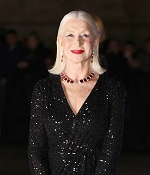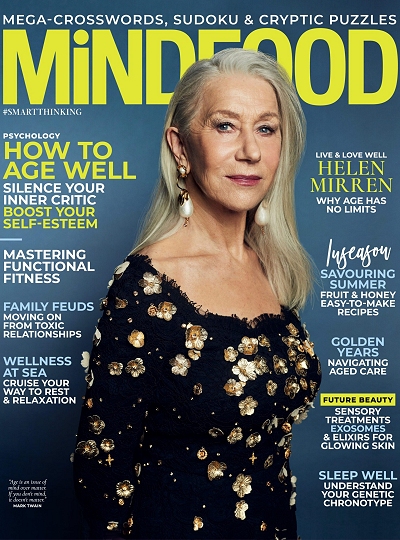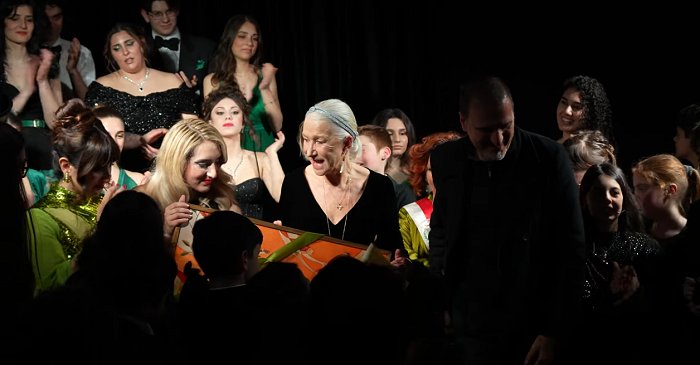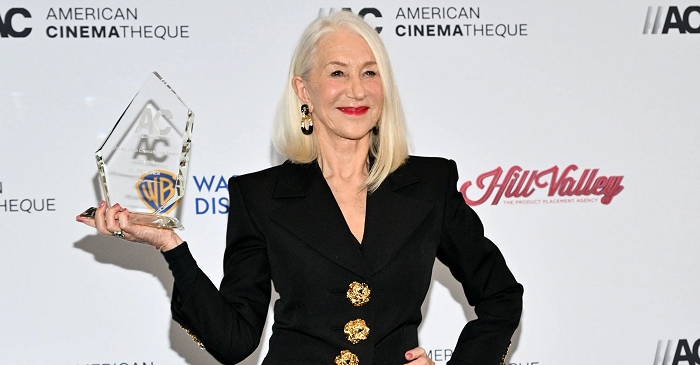
|
Welcome to The Helen Mirren Archives, your premiere web resource on the British actress. Best known for her performances with the Royal Shakespeare Company, "Prime
Suspect" and her Oscar-winning role in "The Queen", Helen Mirren is one of the world's most eminent actors today. This unofficial fansite provides you with all latest
news, photos and videos on her past and present projects. Enjoy your stay.
|
Celebrating
10 years
on the web
|
With raunchy pictures in her new autobiography and nude scenes in several films, who would have thought that Helen Mirren — now in her sixties and an Oscar-winner for her portrayal of the Queen — was a shy teenager? Certainly not a bewitched Barry Egan
‘PROBABLY no other actress can let you know as fast and economically as she can that she’s playing a distinguished and important woman,” the New Yorker’s esteemed Pauline Kael wrote of Helen Mirren in 1985. And Dame Helen — as she became in 2003 — has certainly played enough of them over the years on stage and screen: Lady Torrance in Tennessee Williams’s Orpheus Descending, Christine in Eugene O’Neill’s Mourning Becomes Electra (“It will be hard to be in anything better,” she says), Cleopatra in Antony and Cleopatra (“ I loved playing the serpent of the old Nile”, she says), Cressida in the Royal Shakespeare Company’s Troilus and Cressida, and, of course, Queen Elizabeth II in Stephen Frears’s The Queen. The exacting portrayal of that distinguished woman won Helen an Oscar earlier this year and made her overnight a distinguished and important woman in Hollywood. “ The Oscar does have certain iconic connotations in America,” she says sipping her tea (remembering the night she accepted, dressed in a specially designed Christian Lacroix couture dress, her “little gold man” with the words “Ladies and Gentlemen, I give you the Queen”.)
“ You are, for the rest of your life, an Oscar winner. It is like winning an honour. It becomes part of your name.” She adds that when she first arrived in Los Angeles, movie people would practically push her aside to get to her husband of 10 years, film director Taylor Hackford. Since winning the famous gold statuette from the Academy, they now elbow Taylor aside, she smiles. Before shooting began on the movie, Helen wrote to Her Majesty to say that she would do her best. She received a letter in reply from a Buck House secretary saying that her Royal Highness read the letter with interest and thanked her for letting her know. When the film eventually came out, Helen was invited to a dinner at the palace ( she was unable to attend because of her filming com- mitments in America) where, she believes, she would have been one of about 60 or so others. Helen believes the invitation was “an indication of not necessarily pleasure, but at least not displeasure”. “I don’t think I ever felt so comfortable playing a character as I did with Elizabeth II,” she adds. “I think the comfort came from a love for and respect for all the people of her generation, no matter what their status. It is my parents’ generation.”
Ironically, perhaps, Dame Helen was brought up in an anti-monarchist household in Southend-on-Sea. Her father, Russian emigre Vasily Petrov Mironoff, fought Mosley’s Black Shirts in the East End. Helen’s mother, Kathleen Rogers, was a butcher’s daughter whose grandfather had been the butcher to Queen Victoria. Kathleen was also the thirteenth of 14 children. Vasily and Kathleen were socialists and, says, Helen, disapproved of the idea of class or monarchy. “Being of their era, where the class structure was so oppressive, they had good reason. But I suspect if they were alive now, they’d take a more benign view.” She adds that the world Queen Elizabeth II came out of was that of her parents’ experience — “that sense of tradition and stoicism”. Ah, yes, tradition and stoicism… Once upon a time, Helen’s aristocratic Russian grandfather, Pyotr Vasielivich Mironov, was dispatched to London by the Tsar to negotiate an arms deal in England. He found himself stranded there, along with his family, after the Russian Revolution, unable ever to go home. Helen can remember sitting in her grandfather’s room and him drawing a map of his Russian lands — “where the stables were and where the servants lived”. (Helen‘s father waited until his own father died in the early Fifties to change the family name to Mirren.) “ My great- grandmother was a countess.” Not just an ordinary countess — one who was mentioned in Tolstoy’s War and Peace. Born Ilyena Lydia Mironov in Chiswick, west London in 1945, Helen Mirren is the thinking man’s crumpet. She laughs at the sex symbol image that has hung around her for the last 30 years. Yet Helen has possibly done more than most to encourage it. This should not be construed as a criticism of any sort. I, more than anyone, think it is great that Helen’s autobiography In The Frame is filled with lots of semi-naked and naked pictures of her in variously risque — and decidedly un- Queen Elizabethy — poses…
In a black basque and stockings and suspenders. In striped stockings with her legs east and west. Naked, except for red gloves, through a black veil. Naked in a milk bath — with her face in apparent paroxysms of sexual delight. Naked, crushing apples into a barrel. “Squeezing a bountiful harvest,” says her caption in the book. Her lips photographed wet and in extreme close up. Her ass photographed from a distance as she runs upstairs. Her body photographed from behind in a black thong and camisole — a vaguely S&M neck choker around her neck; all very Eyes Wide Shut. This sense of being confident in her body seems at odds with the young girl who wasn’t allowed on a date until she was 17, and was, she says, “embarrassed by any bodily functions when I was younger. I could never even blow my nose. When I went out on dates as a girl, I could never say, ‘Excuse me, I want to go to the ladies’. That’s why I got a reputation for refusing to kiss anyone at the gate. By the time I got to the gate, I was always dying to go to the loo.” She says that Swinging London completely passed her by, adding that she was working too “intensely and was too obsessed with theatre to notice anything else. Besides whenever I found myself anywhere near the King’s Road it seemed to me that I had stumbled into a club that I most certainly didn’t belong to and where all other members thought I should be ejected ASAP. The girls were thin and longlegged. It was an intimidating environment, especially when, like me, you were found wanting.” Hardly. It didn’t, in any event, take Ms Demure long to lose her inhibitions. In 1968, she caused collective thrombosis among the luvvies when she danced virtually naked across the stage as Cressida. Not long after, the Sunday Times dubbed her Stratford’s Very Own Sex Queen. “ That headline”, she smiles, “was to haunt me for 20 years.” You don’t actually believe her. You believe that deep down she was secretly delighted with it. If she was miffed by it, she had certainly got over it by the time she turned 50: when she posed naked for the cover of the Radio Times.
But that’s Dame Helen for you. She is something of a flirt too. A practised flirt, I might venture. She knows how to twist the male interviewer provocatively around her little finger (and she is well aware that the male interviewer enjoys nothing more than being twisted provocatively around her little finger.) Before arriving for lunch with Helen, I had read a few recent interviews. I noticed that she remarked to the Guardian’s Simon Hattenstone upon entering her room: “ This would be a great place for a romantic weekend, wouldn’t it?” Meanwhile she told Robert Crampton of the London Times that he looked like a Russian aristo — her exboyfriend, Prince George Galitzine. Therefore, I was wondering what, if anything, she was going to say to me when I walked into her suite. “ You look like a Viking,” she says unprompted. “ You should be wearing a sheepskin rug with that long red hair.” I tell her she looks like the Queen in that sunlight coming in through the window. Then immediately feel ridiculous for saying it. She says that there was one piece of film she watched over and over again. Elizabeth was about 12 getting out of one of those big black cars. “She has gloves on and she’s all alone. It’s the way she gets out of the car. She puts her hand forward,” Helen recalls. “She’s just doing everything absolutely correctly… that was long before she had any idea that she was going to be Queen. She does it with such a sense of dignity and seriousness and discipline.” Seriousness would be a good word to put next to Helen Mirren. She seems to have that aura of someone who could be quite happily lost in solitary thought. “I was always rather interior, rather Russian,” she says, adding that she and her sister have what they call their “ Russian moments”. The Irish could lay claim to similar interior moments of the soul, I say. “As could the Italians.” And the Germans. “And the French.” And the English. “ Yes. It is just a human thing.” So says the woman who as a young girl slept with an image of Goya’s face under her pillow because she thought that somehow she’d been caught in the wrong time zone and was supposed to be Goya’s mistress or wife. Her intensity was possibly inherited from her mother Kathleen, who once held her out of the window and said: “If you don’t stop crying, I’m going to drop you.” When 87-year-old Kathleen died, her last will and testament requested that no funeral be held. She was a lifelong atheist, like her daughter. “Hell is on Earth,” Helen says. “Hell is in Darfur or wherever.”
And hell was that scene in Peter Greenaway’s The Cook, The Thief, His Wife and Her Lover when savage spiv and restaurant proprietor (played by Michael Gambon) finds out that his wife (Helen’s character) has sex in the toilet of his restaurant night after night with an intellectual man. Gambon and his goons murder him by forcing a suitably intellectual book on the French Revolution, page by blood-stained page, down his throat with a spike. Helen, needless to say, was extraordinary in that movie. She is an intriguing woman. Read this from the Daily Mail of 1970: “When I was a little girl I vowed that when I made it, I wouldn’t be just good. I wouldn’t be just brilliant. I would be the greatest thing there ever was.” She remembers as a very little girl the delights that a scoop of Rossi’s ice-cream dropped in Cherryade would bring. She remembers going in to London for the first time from Southend- on- Sea and the school bus stopping outside the public lavatories in Dagenham. We both burst out laughing — finding the sentence “stopping outside the public lavatories in Dagenham” hilarious. We can’t agree whether it owes more to Joe Orton or Morrissey . And just as you are getting over the fact that Dame Helen is a fan of Morrissey, another shock is in store for you. She admires both Paris Hilton and Jeremy Clarkson. It is quite something to hear a descendant of the White Russian nobility eulogise Hilton and Clarkson in the same breath, but there you are.
“Jeremy Clarkson and Paris Hilton are one and the same, because they are smart and deliberately milking it,” she says of the LA diva and the host of the BBC’s Top Gear. They are both examples of exaggerated maleness and exaggerated femaleness.” Like Dame Helen in her stockings and suspenders on page 155 of her book. Happily, the dame’s still game. ‘In The Frame: My Life in Words and Pictures’ (£24.99, Weidenfeld & Nicholson)












